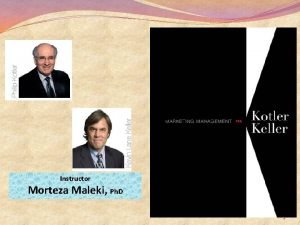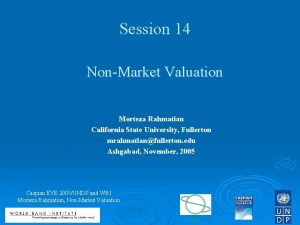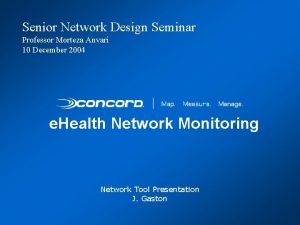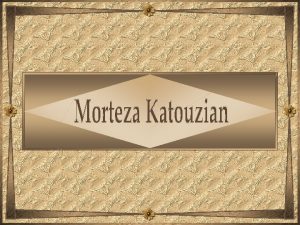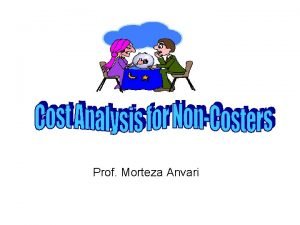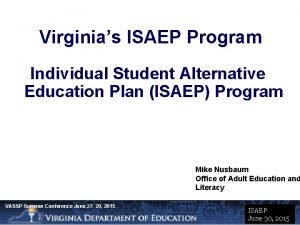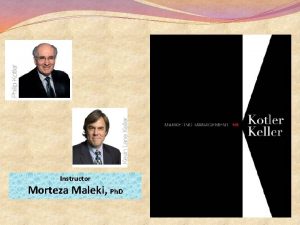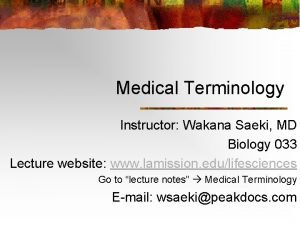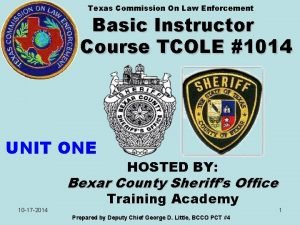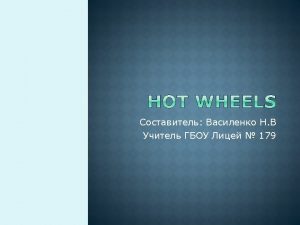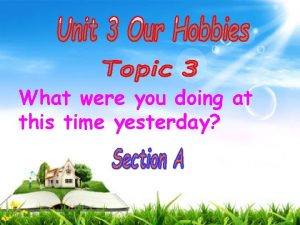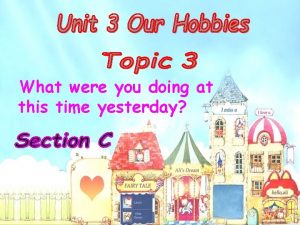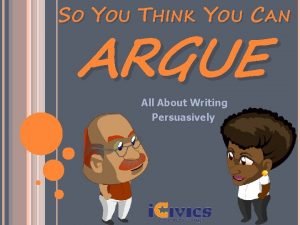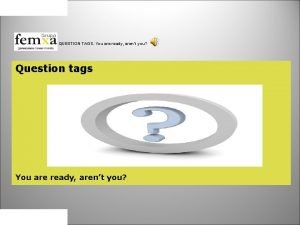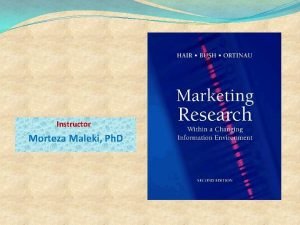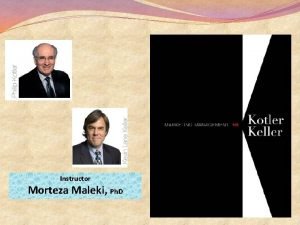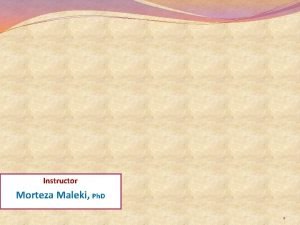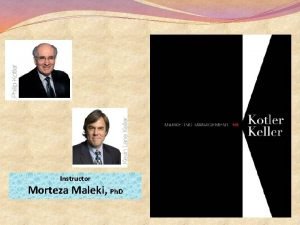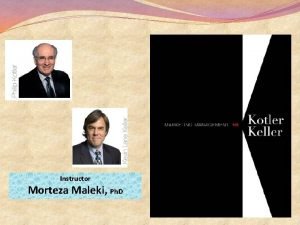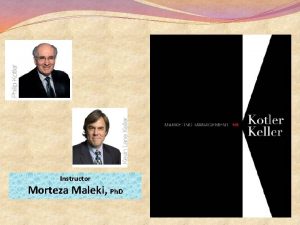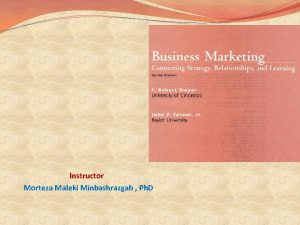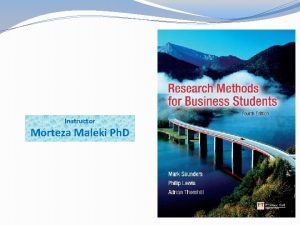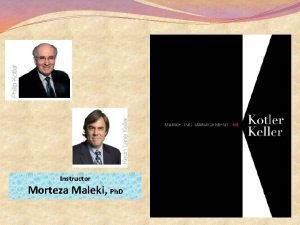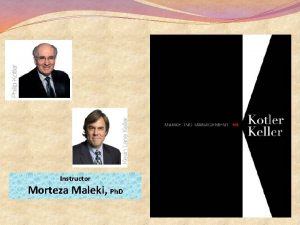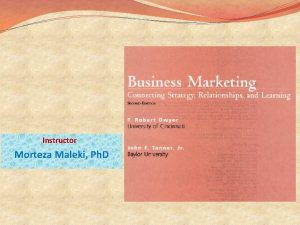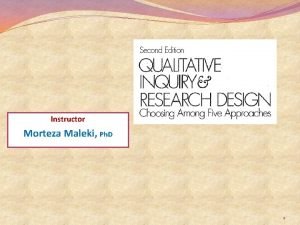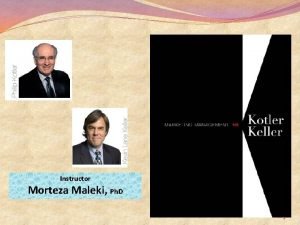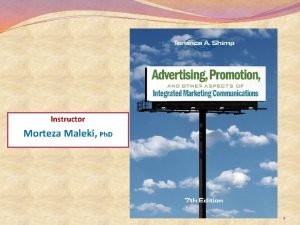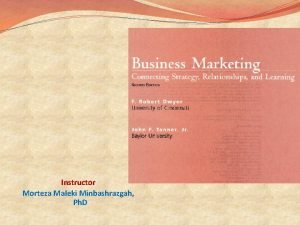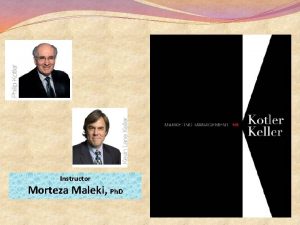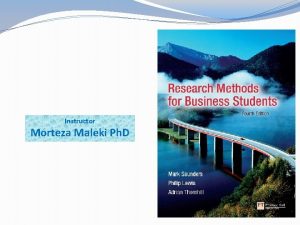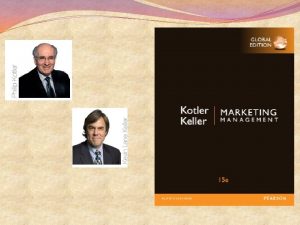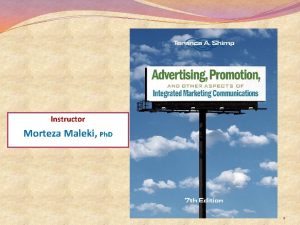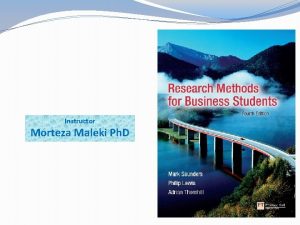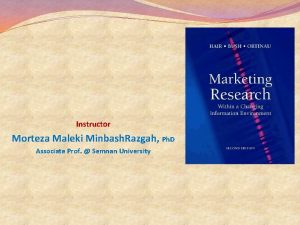Instructor Morteza Maleki Ph D 2 3 You



































































- Slides: 67

Instructor Morteza Maleki Ph. D

2

3

ü You have almost certainly already been asked by your tutors to ‘review the literature’, ‘write a literature review’ or ‘critically review the literature’ on topics they have specified. ü The real reason for being afraid of this part of the research is twofold: 1. The requirement to make judgments as to the value of each piece of work 2. The requirement to organise those ideas and findings that are of value into a review 4

ü Two major reasons exist for reviewing the literature (Sharp et al. , 2002): 1. 2. First, the preliminary search helps you to generate and refine your research ideas. The second, often referred to as the critical review or critical literature review, is part of your research project proper. ü Project assessment criteria usually require you to demonstrate awareness of the current state of knowledge in your subject, its limitations, and how your research fits in this wider context (Gill and Johnson, 2002). 5

ü The significance of your research and what you find out will inevitably be judged in relation to other people’s research and their findings. ü You need both to ‘map and assess the existing intellectual territory’ (Tranfield et al. , 2003: 208), establishing what research has been published in your chosen area, and, to try to identify any other research that might currently be in progress. ü The items you read and write about will enhance your subject knowledge and help you to clarify your research question(s) further, the process called critically reviewing the literature. 6

The purpose of the critical review ü The precise purpose of reading of the literature depends on the approach you are intending to use in your research. ü ü For some research projects you will use the literature to help you to identify theories and ideas that you will test using data. This is known as a deductive approach, in which you develop a theoretical or conceptual framework, which you subsequently test using data. For other research projects you will be planning to explore your data and to develop theories from them that you will subsequently relate to the literature. This is known as an inductive approach, and, although your research still has a clearly defined purpose with research question(s) and objectives, you do not start with any predetermined theories or conceptual frameworks. 7

ü The purpose of your literature review is not to provide a summary of everything that has been written on your research topic, but to review the most relevant and significant research on your topic. ü If your analysis is effective, new findings and theories will emerge that neither you nor anyone else has thought about (Strauss and Corbin, 1998). ü When you write your critical review, you will need to show your findings and theories you have developed or are using relate to the research that has gone before, thereby demonstrating that you are familiar with what is already known about your research topic. 8

ü Critical review of literature has some other purposes (Gall et al. 2002): 1. To help you to refine further your research question(s) and objectives; 2. To highlight research possibilities that have been overlooked implicitly in research to date; 3. To discover explicit recommendations for further research. ü These can provide you with a superb justification for your own research question(s) and objectives; 4. To help you to avoid simply repeating work that has been done already; 5. To sample current opinions in newspapers, professional and trade journals, thereby gaining insights into the aspects of your research question(s) and objectives that are considered newsworthy; 6. To discover and provide an insight into research approaches, strategies and techniques that may be appropriate to your own research question(s) and objectives. 9

The Content of the Critical Review ü Literature review will need to evaluate the research that has already been undertaken in the area of the research project, show and explain the relationships between published research findings and reference the literature in which they were reported. ü It will draw out the key points and trends (recognizing any omissions and bias) and present them in a logical way which also shows the relationship to your own research. 10

ü Researchers need to provide readers of the project report with the necessary background knowledge to the research question(s) and objectives and establish the boundaries of the research. ü It will also enable the readers to see the ideas against the background of previous published research in the area. ü This does not necessarily mean that the ideas must extend, follow or approve those set out in the literature. ü Researcher may be highly critical of the earlier research reported in the literature and seek to discredit it. 11

ü In considering the content of the critical review, one will therefore need: 1. 2. 3. ü To include the key academic theories within the chosen area of research; To demonstrate that the knowledge of the chosen area is up to date; Through clear referencing, enable those reading the project report to find the original publications researchers cite. By fully acknowledging the research of others you will avoid charges of plagiarism and the associated penalties. 12

13

What is Really meant by being ‘Critical’ about the Content ü Mingers (2000: 225– 6) argues that there are four aspects of a critical approach that should be fostered by management education: 1. 2. 3. 4. Critique of Rhetoric Critique of Tradition Critique of Authority Critique of Objectivity 14

ü The ‘critique of rhetoric’ means appraising or evaluating a problem with effective use of language. ü In the context of the critical literature review, this emphasizes the need for the reviewer to use the skills both of making reasoned judgments and of arguing effectively in writing. ü The other three aspects also have implications for being critical when reading and writing about the work of others. ü This includes researchers questioning, where justification exists to do so, the conventional wisdom, the ‘critique of tradition’ and the dominant view portrayed in the literature you are reading, the ‘critique of authority’. ü Finally, it is likely that the knowledge and information researchers are discussing are not value free, the ‘critique of objectivity’. 15

ü In critically reviewing the literature, researchers need to read the literature about the research topic with some skepticism and be willing to question what they read. ü This means researchers need to be constantly considering and justifying with clear arguments their own critical stance. ü They will therefore have to read widely on your research topic and have a good understanding of the literature. ü It requires researchers to have gained topic-based background knowledge, understanding, the ability to reflect upon and to analyse the literature and, based on this, to make reasoned judgments that are argued effectively. 16

17

ü Dees (2003) suggests that being critical means researcher should: 1. Refer to and assess research by recognised experts in your chosen area; 2. Consider and discuss research that supports and research that opposes your ideas; 3. Make reasoned judgments regarding the value of others’ research, showing clearly how it relates to your research; 4. Justify your arguments with valid evidence in a logical manner; 5. Distinguish clearly between fact and opinion. 18

The Structure of the Critical Review ü The literature review should be a description and critical analysis of what other authors have written (Jankowicz, 2005). ü Researchers need to focus on their research question(s) and objectives. ü One way to do so is to ask: How far existing published research goes in answering the research question(s)? ü Then, the shortfall in the literature will be addressed, at least partially, in the remainder of the project report. 19

ü Another way of helping you to focus is to ask: How the review relates to the objectives? ü If it does not, or does only partially, there is a need for a clearer focus on the objectives. ü The precise structure of the critical review is usually the researchers’ choice, although they should check, as it may be specified in the assessment criteria. ü Three common structures are: 1. A single chapter 2. A series of chapters 3. Throughout the project report as you tackle various issues 20

ü A common mistake with critical literature reviews is that they become uncritical listings of previous research. ü Often they are little more than annotated bibliographies (Hart, 1998), individual items being selected because they fit with what the researcher is proposing (Greenhalgh, 1997). 21

ü Although there is no single structure that the critical review should take, one can think of the review as a funnel in which researcher: 1. Start at a more general level before narrowing down to your specific research 2. 3. 4. 5. 6. 7. question(s) and objectives; Provide a brief overview of key ideas and themes; Summarise, compare and contrast the research of the key writers; Narrow down to highlight previous research work most relevant to your own research; Provide a detailed account of the findings of this research and show they are related; Highlight those aspects where your own research will provide fresh insights; Lead the reader into subsequent sections of your project report, which explore these issues. 22

ü In order to improve the transparency of the review process, researchers should explain precisely how they searched for selected the literature they have included in their review, outlining their choice of key words and of databases used (Tranfield et al. , 2003). 23

24

An Overview ü The literature sources can be divided into three categories: 1. Primary (Published and Unpublished), 2. Secondary, and 3. Tertiary 25

ü Primary literature sources (grey literature) are the first occurrence of a piece of work. ü They include published sources such as reports and some central and local government publications such as White Papers and planning documents. ü They also include unpublished manuscript sources such as letters, memos and committee minutes that may be analyzed as data in their own right. ü Secondary literature sources such as books and journals are the subsequent publication of primary literature. ü These publications are aimed at a wider audience. ü They are easier to locate than primary literature as they are better covered by the tertiary literature. 26

ü Tertiary literature sources, also called search tools, are designed either to help to locate primary and secondary literature or to introduce a topic. ü They therefore include indexes and abstracts as well as encyclopedias and bibliographies. 27

Secondary Literature Sources ü The number of secondary literature sources is expanding rapidly, as new resources are developed or made available via the Internet. ü The most important when placing your ideas in the context of earlier research are refereed academic journals. ü Books are likely to be more important than professional and trade journals in this context. 28

29

1) Journals ü Journals are also known as periodicals, serials and magazines, and are published on a regular basis. ü Either in printed form, as well as online access, via a subscription service. ü Articles in refereed academic journals are evaluated by academic peers prior to publication, to assess their quality and suitability. ü Most other academic journals will have an editor and possibly an editorial board with subject knowledge to select articles. 30

ü Professional Journals are produced for their members by organisations. ü Like the Association of Chartered Certified Accountants (ACCA) and the American Marketing Association (AMA) ü They contain a mix of news-related items and articles that are more detailed. ü Articles can be biased towards their author’s or the organisation’s views. ü Articles are often of a more practical nature and more closely related to professional needs than those in academic journals. ü Trade journals fulfil a similar function to professional journals. ü They are published by trade organisations or aimed at particular industries or trades such as catering or mining. ü Often they focus on new products or services and news items. ü They rarely contain articles based on empirical research. 31

2) Books ü Books and monographs are written for specific audiences. ü ü Some are aimed at the academic market, with a theoretical slant. Others, aimed at practising professionals, may be more applied in their content. ü The material in books is usually presented in a more ordered and accessible manner than in journals. ü They are therefore particularly useful as introductory sources to help clarify your research question(s) and objectives or the research methods you intend to use. 32

3) Newspapers ü Newspapers are a good source of topical events, developments within business and government, as well as recent statistical information such as share prices. ü They also sometimes review recent research reports. ü The main ‘quality’ newspapers have websites carrying the main stories and supporting information. ü Back copies starting in the early 1990 s are available on CD-ROM or online via a full-text subscription service, such as Proquest Newspapers. 33

Primary Literature Sources ü The most accessible, and those most likely to be of use in showing how your research relates to that of other people, are reports, conference proceedings and theses. 34

1) Reports ü Reports include market research reports such as government reports and academic reports. ü ü Even being able to locate them, it is difficult to gain access to them because they are not as widely available as books. Reports are not well indexed in the tertiary literature. ü The move toward ‘freedom for information’ has resulted in more information being made available via the web. ü For example, European ‘grey literature’, including reports, conference proceedings, and discussion and policy papers, has been covered since 1980 by SIGLE (System for Information on Grey Literature in Europe) and is available from the publisher OVID. 35

2) Conference Proceedings ü Conference proceedings, sometimes referred to as symposia, are often published as unique titles within journals or as books. ü Most conferences will have a theme that is very specific, but some have a wide-ranging overview. ü Proceedings are not well indexed by tertiary literature so, as with reports, you may have to rely on specific search tools such as Index to Conference Proceedings. 36

3) Theses ü Theses are unique and so for a major research project can be a good source of detailed information; they will also be a good source of further references. ü They can be difficult to locate and, when found, difficult to access as there may be only one copy at the awarding institution. ü Specific search tools are available, such as Index to Theses. ü Only research degrees such as Ph. D and MPhil are covered well by these tertiary resources. ü Research undertaken as part of a taught masters degree is not covered as systematically. 37

ü Time spent planning will be repaid in time saved when searching the literature. ü As you start to plan your search, you need to beware of information overload! ü Before commencing your literature search, researchers should undertake further planning by writing down the search strategy: 1) The parameters of the search; 2) The key words and search terms researchers intend to use; 3) The databases and search engines researchers intend to use; 4) The criteria researchers intend to use to select the relevant and useful studies from all the items they find. 38

Defining the parameters of your search ü Researchers need to be clear about the following (Bell, 2005): 1) Language of publication (for example, English); 2) Subject area (for example, marketing); 3) Business sector (for example, manufacturing); 4) Geographical area (for example, Europe); 5) Publication period (for example, the last 10 years); 6) Literature type (for example, refereed journals and books) 39

There’s nothing written on my research topic ü This is usually because they have identified one or more of their parameters too narrowly. ü If you encounter this problem you broaden one or more of your parameters to include material that your narrower search would not have located. 40

41

Generating your key words ü Recent review articles in your research area are often helpful as they discuss the current state of research for a particular topic and can help you to refine your key words. ü They will probably contain references to other work that is pertinent to your research question(s) and objectives. ü Another potentially useful source of references is dissertations and theses in your university’s library. 42

ü The identification of key words or search terms is the most important part of planning your search for relevant literature (Bell, 2005). ü Key words are the basic terms that describe your research question(s) and objectives, and will be used to search the tertiary literature. ü Key words can be identified using: 1) Discussion with colleagues, your project tutor and librarians 2) Initial reading 3) Dictionaries, thesauruses, encyclopaedias and handbooks 4) Brainstorming 5) Relevance trees 43

ü Relevance trees provide a useful method of bringing some form of structure to your literature search and of guiding your search process (Sharp et al. , 2002). ü They look similar to an organisation chart and are a hierarchical ‘graph-like’ arrangement of headings and subheadings. 44

45

ü These headings and subheadings describe your research question(s) and objectives and may be key words (including authors’ names) with which you can search. ü Relevance trees are often constructed after brainstorming. ü They enable you to decide either with help or on your own (Jankowicz, 2005): ü Which key words are directly relevant to your research question(s) and objectives; ü Which areas you will search first and which your search will use later; ü Which areas are more important – these tend to have more branches. 46

ü To construct a relevance tree: 1) Start with your research question or objective at the top level. 2) Identify two or more subject areas that you think are important. 3) Further subdivide each major subject area into sub-areas that you think are of relevance. 4) Further divide the sub-areas into more precise sub-areas that you think are of relevance. 5) Identify those areas that you need to search immediately and those that you particularly need to focus on (your project tutor will be of particular help here). 6) As your reading and reviewing progress, add new areas to your relevance tree. 47

ü Literature search will probably be conducted using a variety of approaches: 1) Searching using tertiary literature sources 2) Obtaining relevant literature referenced in books and journal articles you have already read 3) Scanning and browsing secondary literature in your library 4) Searching using the Internet 5) Using a variety of these in combination 48

Tertiary literature sources ü A variety of tertiary literature, like indexes and abstracts, is available. ü An index will index articles from a range of journals and sometimes books, chapters from books, reports, theses, conferences and research. ü The information provided will be sufficient to locate the item for journal articles: 1) 2) 3) 4) 5) 6) Author or authors of the article Date of publication Title of the article Title of the journal Volume and part number of the journal issue Page numbers of the article 49

ü Most index searches will be undertaken to find articles using key words, including the author’s name. ü You may wish to search by finding those authors who have referenced (cited) a key article after it has been published. ü A citation index enables you to do this as it lists by author the other authors who have cited that author’s publications subsequent to their publication. 50

ü An abstract provides the same information as an index but also includes a summary of the article, hence the term abstract. ü This abstract can be useful in helping you to assess the content and relevance of an article to your research before obtaining a copy. ü You should beware of using abstracts, as a substitute for the full article, as a source of information for your research. ü They contain only a summary of the article and are likely to exclude much of relevance. 51

Searching using tertiary literature ü In searching using tertiary literature, you need to: 1) Ensure your key words match the controlled index language (unless you can use free text searching); 2) Search appropriate printed and database sources; 3) Note precise details, including the search strings used, of the actual searches you have undertaken for each database; 4) Note the full reference of each item found; this can normally be done by cutting and pasting the references. 52

Databases ü Databases allow more precise searches using combinations of search terms. ü These can include indexed key words, which will need to match the 53

ü Once individual key words have been checked, subsequent searches normally use a combination of key words linked using Boolean logic. ü These are known as search strings and enable you to combine, limit or widen the variety of items found using link terms. ü Boolean logic can also be used to construct search strings using dates, journal titles and names of organisations or people. 54

55

ü Many databases allow you to search the entire database rather than just the controlled vocabulary using free text searching. ü Free text searching is increasingly common for electronic publications both on CD- ROM and accessed via the Internet, in particular quality newspapers and journals. 56

57

Scanning and browsing ü Any search will find only some of the relevant literature. ü New publications such as journals are unlikely to be indexed immediately in tertiary literature, so you will need to browse these publications to gain an idea of their content. ü In contrast, scanning will involve you going through individual items such as a journal article to pick out points that relate to your own research. ü You browse and scan trade and professional journals, as these are less likely to be covered by the tertiary literature. 58

ü To make browsing and scanning easier you should: 1) Identify when those journals that are the most relevant are published and regularly 2) 3) 4) 5) browse them; Browse new book displays in libraries; Scan new book reviews in journals and newspapers; Scan publishers’ new book catalogues where available; Discuss your research with your project tutor and librarians, who may be aware of other relevant literature. ü Article alert service will provide a regular email update of articles in your area of interest. 59

Searching the Internet ü Internet - a worldwide network of computers providing access to a vast range of literature and other resources ü Websites dedicated to providing support information on searching the Internet 1. Phil Bradley (http: //www. philb. com/) ü This contains information on different search engines, articles on Internet searching and web page and website design and is regularly updated. RBA Information Services (http: //www. rba. co. uk/) 2. ü It contains an excellent directory of business-related websites as well as a wealth of more generic information on searching the Internet. 60

61

Search tools ü Search tools - search engines are important method of Internet searching for your literature review ü They will enable you to locate most current and up-to-date items. ü Most search tools search by key words or subject trees. ü A subject tree is similar to a contents page or index. ü Some are in the form of alphabetical subject lists, whereas others are in hierarchical groups of subjects that are then further subdivided with links to more narrowly focused subject groups. ü Each search tool will have different interfaces, ways of searching and methods of displaying information. 62

ü Search tools can be divided into four distinct categories: 1) General search engines; 2) Meta search engines; 3) Specialised search engines and information gateways; 4) Subject directories. ü General search engines normally search parts of the Internet using key words and Boolean logic or a phrase. ü Each search engine uses an automated computer process to index and search, often resulting in a very large number of sites being found. 63

ü Meta search engines allow you to search using a selection of search engines at the same time, using the same interface. ü This makes searching easier, and the search can be faster. it is less easy to control the sites that are retrieved. ü Consequently meta search engines often generate more inappropriate or unreliable sites than general search engines. ü Specialised search engines cater for specific subject areas. ü To use these it is necessary to define your general subject area prior to your search. ü Information gateways also require you to define your subject area. ü They are often compiled by staff from departments in academic institutions. 64

65

66

The End 67
 Morteza maleki
Morteza maleki Example of data gathering procedure
Example of data gathering procedure Reza entezari maleki
Reza entezari maleki Morteza rahmatian
Morteza rahmatian Morteza anvari
Morteza anvari Morteza katouzian
Morteza katouzian Cost analysis requirements description
Cost analysis requirements description Morteza farajian
Morteza farajian Morteza farajian
Morteza farajian Isaep
Isaep Morteza farajian
Morteza farajian Please clean your room
Please clean your room Tipología de los participantes
Tipología de los participantes Basic instructor course texas
Basic instructor course texas Basic instructor course texas
Basic instructor course texas Basic instructor course tcole
Basic instructor course tcole Pepperball launcher nomenclature
Pepperball launcher nomenclature Subject verb agreement exercise
Subject verb agreement exercise Instructor vs teacher
Instructor vs teacher Ospfv
Ospfv Mptc instructor
Mptc instructor Basic instructor course texas
Basic instructor course texas Basic instructor course #1014
Basic instructor course #1014 Virtual instructor art
Virtual instructor art Nfpa 1403
Nfpa 1403 Human factors instructor
Human factors instructor Instructor operating station
Instructor operating station Catia instructor
Catia instructor Instructor
Instructor Ac 61-98 plan of action
Ac 61-98 plan of action Tcole 1014 basic instructor course
Tcole 1014 basic instructor course Jrotc marksmanship instructor course online
Jrotc marksmanship instructor course online Nrp instructor toolkit
Nrp instructor toolkit Utp cable
Utp cable What is cbrf training
What is cbrf training Nra certified instructor logo
Nra certified instructor logo Naismith was an instructor of
Naismith was an instructor of Tcole advanced instructor course
Tcole advanced instructor course Tcole advanced instructor course
Tcole advanced instructor course Jrotc marksmanship instructor course online
Jrotc marksmanship instructor course online エイムズの部屋
エイムズの部屋 Cyan medical terminology
Cyan medical terminology Basic instructor course #1014
Basic instructor course #1014 Basic instructor course tcole
Basic instructor course tcole Delmar cengage learning instructor resources
Delmar cengage learning instructor resources Instructor office hours
Instructor office hours Do you love the rain
Do you love the rain Agree or disagree questions about life
Agree or disagree questions about life If you think you can you can poem
If you think you can you can poem Tell me what you eat and i shall tell you what you are
Tell me what you eat and i shall tell you what you are Wherever you go i will follow you
Wherever you go i will follow you You were the one at the beginning
You were the one at the beginning Like you thought
Like you thought Visual rhetoric
Visual rhetoric You can't turn right
You can't turn right When life kicks you let it kick you forward
When life kicks you let it kick you forward You remember what you were doing at this time yesterday
You remember what you were doing at this time yesterday You remember what you were doing at this time yesterday
You remember what you were doing at this time yesterday Jack prelutsky homework oh homework
Jack prelutsky homework oh homework They say it only takes a little faith to move a mountain
They say it only takes a little faith to move a mountain To take something that doesn't belong to you
To take something that doesn't belong to you Homework oh homework i hate you you stink
Homework oh homework i hate you you stink Spoken word poetry allows you to be anyone you want to be
Spoken word poetry allows you to be anyone you want to be Have a daughter so you can argue
Have a daughter so you can argue 5 apples in a basket riddle
5 apples in a basket riddle Nothing is ready question tag
Nothing is ready question tag The more you study the more you learn
The more you study the more you learn Jack prelutsky homework oh homework
Jack prelutsky homework oh homework
